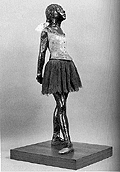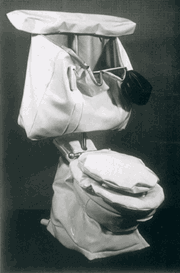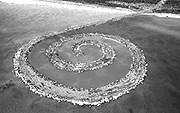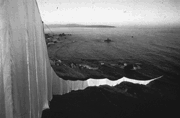| back to: Chapter 8

Little Dancer 14 Years Old
Edgar Degas
sculpture
1880-81 (Impressionist)

Soft Toilet
Claes Oldenburg
sculpture
1966 (Pop Art)

Spiral Jetty
Robert Smithson
sculpture
1970 (Earthwork)

Running Fence
Christo
sculpture
1972-76 (Earthwork)
|
Chapter 9: Sculpture
Subtractive and Additive Types of Sculpture
- CARVING
is a sculptural method that involves removing material from a larger form to create and image. An excellent example of a carved sculpture is the Spearbearer by Polykleitos of Argos.
- MODELING
is a sculptural method that usually involves clay, but can be made of any plastic and pliable material that can be manipulated without adding or subtracting material.
- CASTING
The ancient Greeks used the lost wax method of bronze sculpture. Edgar Degas' Little Dancer 14 Years Old is an excellent example of bronze lost wax sculpture.
- CONSTRUCTION
Like Louise Nevelson's Sky Cathedral, a constructed work is one that is pieced together and can be added to or subtracted from in any combination.
Types of Materials
- STONE SCULPTURE
one of the most durable materials, but not forgiving to the artist. The Venus of Willendorf is the oldest example of a work of art that we know of. It was done between 12,000-42,000 years ago.
- WOOD SCULPTURE
like stone, ancient examples of wood sculpture exist, but it is less permanent, so fewer examples survive. Native American Artists often used wood as a medium for the creation of masks.
- CLAY SCULPTURE
clay is pliable and can be fired into a permanent state. The ancient Etruscan artists used a clay material called terre cotta to fashion their sculptures.
- METAL SCULPTURE
has a high tensile strength and can be made more pliable with the application of heat. The Italian Renaissance artist Ghiberti fashioned a series of relief sculptures in bronze that make up the doors of Florence baptistry.
Modern and Contemporary Materials and Methods
- CONSTRUCTED SCULPTURE
the work is constructed from one or many different types of materials. The Pop Artist Claes Oldenburg constructed Soft Toilet from vinyl, kapok, cloth, and Plexiglas.
- ASSEMBLAGE
this type of sculpture involves collecting existing units (found objects) and organizing the collection into visual compositions. Louise Nevelson's Sky Cathedral is a good example of an assemblage.
- READYMADES
is a term first coined by Marcel Duchamp who created many of his works from objects that already existed in the world. Duchamp merely changed their function by reassociating them.
- MIXED MEDIA
artists use a variety of materials and techniques with no intention of keeping the "purity" of the material characteristics. Simon Rodia's Watts Towers is a testament to mixed media sculpture, architecture and "outsider" art.
- KINETIC SCULPTURE
is sculpture that involves actual movement. This movement can be initiated by evironmental forces, the viewer, or some other source. Alexander Calder first pioneered kinetic sculpture with his invention of the mobile in the early 20th Century.
- LIGHT SCULPTURE
is sculpture that is created through the articulation of light in an environment. James Turrell is a contemporary artist who investigates our perception using light.
- EARTHWORKS
are works that involve changing the land with heavy equipment in order to create a sculptural form. The artist Robert Smithson first used the term to describe his works.
- RECENT SCULPTURE
Although it does not involve moving the earth, Christo's works use the landscape to create his sculptures. In Running Fence he uses cloth to articulate the contours of the California coast. Surrounded Islands also uses cloth to punctuate Miami's Biscayne Bay.
Chapter 10
| |
|
